Residential areas, temples, arenas and aqueducts – in the Great City of Rome board game, players compete to be the best city planner in the Eternal City.
Would you rather expand the residential area or build the Temple of Juno? First provide for yields from vineyards and grain farms or secure the water supply with aqueducts? The city planners of the Roman Empire certainly faced questions like these, and they are central to the Great City of Rome board game, the new city-building game from Abacusspiele-Verlag.
What is special about this board game?
In what way is the Great City of Rome board game different from other citybuilding games?
We answer these questions in our review, explain how to play and give our assessment of the most important pros and cons in the conclusion.
Note on transparency: The publisher Abacusspiele kindly sent us a review copy of the game free of charge. However, this review is neither compensated nor agreed upon in terms of content and reflects our own opinion.
The Great City of Rome Board Game at a Glance
- Game type: Strategy game, Citybuilding game, Connoisseur game
- Age: from 10 years
- Players: 2 – 4 players
- Duration: approx. 60 min.
- Publisher: Abacusspiele
- Game Author: Matthew Dunstan & Brett J. Gilbert
- Publication year: 2018
- Game Objective: To build your own version of ancient Rome and make it the prosperous navel of the world through strategic decisions.
How to Play the Great City of Rome Board Game
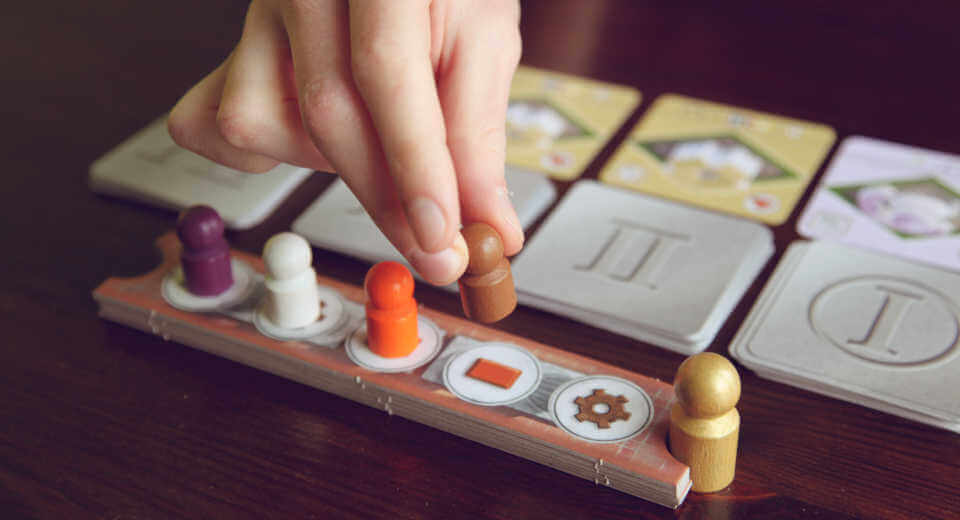
The object of this game is for everyone to build their own design of Rome. This means that each player starts with the same two building cards and at the end of the game has a maximum 4 x 4 square of just such cards in front of him. Only the final evaluation shows which version of Rome is the most successful and thus who is the winner.
Game Material and Preparation
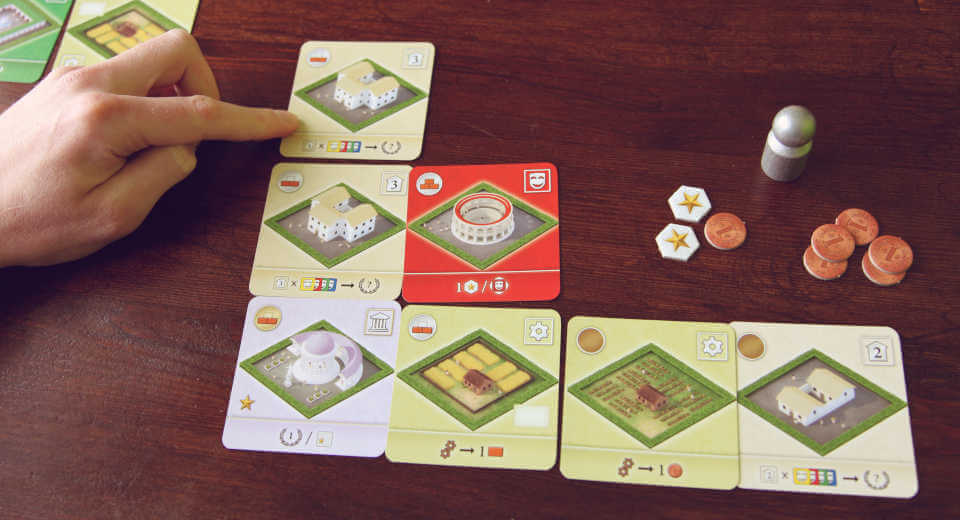
The 80 building cards are all square and can be divided in two ways. Firstly, there are 8 starting player cards (reverse side in player colour) and 4 piles whose cards show the Roman numerals I to IV. On the other hand, there are 5 different types of buildings with different functions:
- Residential buildings: should be grouped together into residential quarters if possible, must be adjacent to at least one public building
- Production buildings: vegetable farms, grain farms, sheep farms or vineyards – bring money, influence or building points
- Public buildings: come in 4 types: market, arena, school and spa, having as many different ones as possible is good
- Aqueducts: bring victory points at the end
- Temples: there are 10 different ones and each one only once, bring bonus victory points at the end if certain conditions are met
Each player starts with a residential building of value 2 and a vegetable farm, which yields money when production is triggered. The 4 piles with the remaining building cards are each shuffled and placed next to each other in the centre of the table.
Next to them there is a pile with 6 so-called action strips. These show different sequences of 3 clay bricks and 2 cogwheels, which stand for building points and production points. At one end of the pile, a golden emperor figure marks the beginning.
There are also money tokens, influence, building point and victory point markers, a silver starting player figure and a scoring block, although you don’t need it until the very end.
Operation of a Round
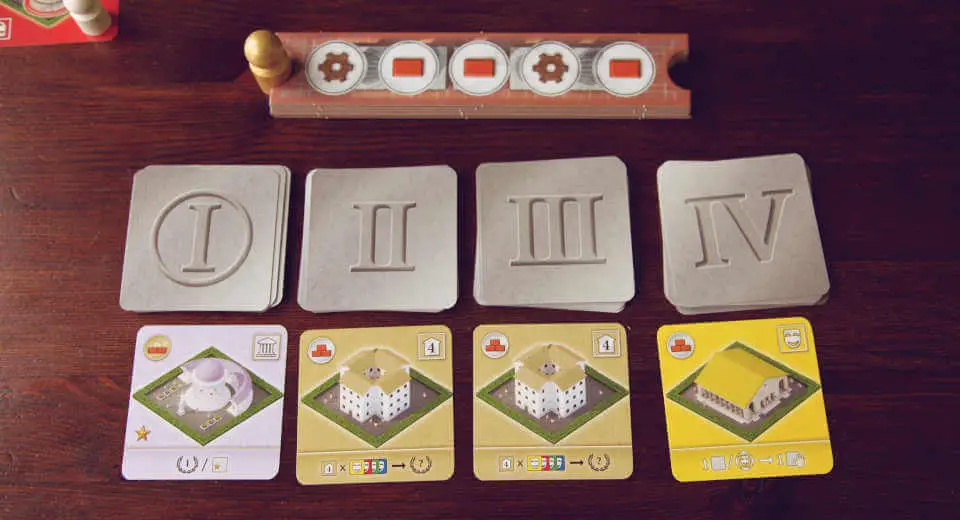
After a few more small preparations, the Great City of Rome board game can begin. Each game always consists of 14 rounds, with each round consisting of 3 phases. In turn, each of the players is the starting player of a round once, which is indicated by the starting player figure moving on.
Preparation Phase
In the preparation phase, the top action strip is picked up, turned over and pushed under the pile. Then you turn over a new card from each of the four piles. These represent the building supply in that round.
Setting Phase
Starting with the starting player, all players now take turns to place their piece on one of the squares on the action strip. On the one hand, this determines the order of play in the action phase; on the other hand, the placement of a piece also affects the action points in the coming phase.
The closer a figure is to the emperor (the golden figure on one side of the action strip), the sooner it takes its turn and can secure the best card on offer. But the further from the emperor one stands, the more action points are available for building and production.
Action Phase
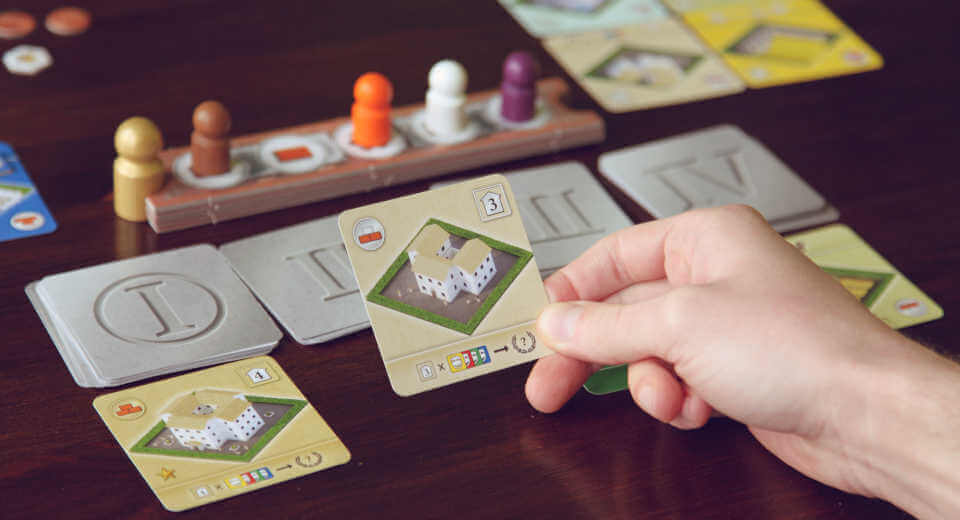
Now each player makes their move, in the order in which their pieces are placed from the emperor. This is where it often becomes apparent what an advantage it can be to be at the very front. Especially in the later stages of the game, it often happens that several players fight over a certain card, because it can offer them a decisive advantage for their own city. On the other hand, it can sometimes be more advantageous to deliberately place oneself further back in order to be able to build and produce more.
Now the player can build exactly once per turn and produce once if he wants to and can. You can build either the card you have just taken or one of your hand cards, as long as you have the necessary building points. You get them through your position on the action strip in this round or in the form of a building tile or you can buy them for 2 money each.
You always need two production points for production. If you lack one or even both, you can buy them for 1 money per point. The production action always gives something to all production fields in your city: money, building tiles or an influence marker.
The Evaluation – What Gives Points in the End?
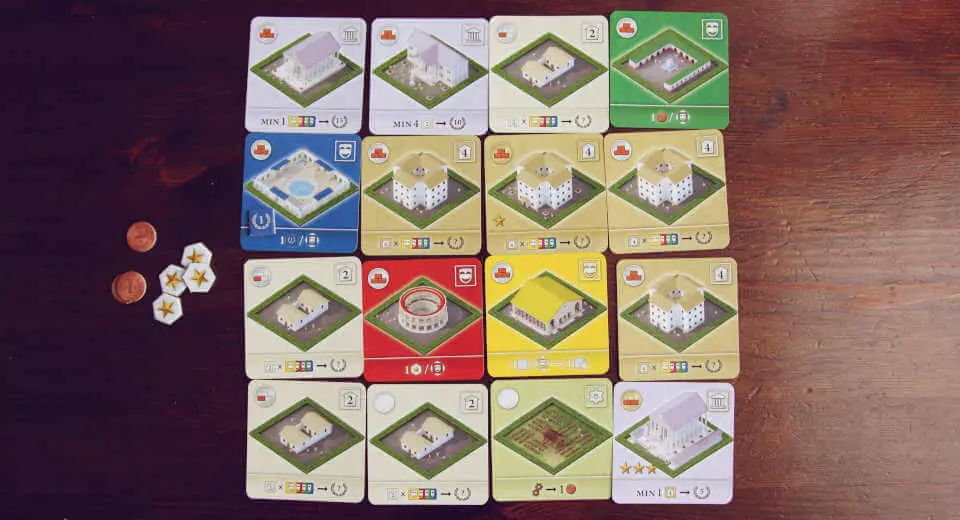
The Great City of Rome board game offers various strategic possibilities to collect victory points. Residential buildings are counted in contiguous neighbourhoods of the same type, but only count at all if public buildings are adjacent to them, which function as multipliers. A residential area should border as many differently coloured public buildings as possible.
The aqueducts and temples now also score points according to certain rules and also the remaining money, the collected influence markers and any influence cards won.
When calculating the final points of each player, the scoring pad provided is a good help to not forget any point.
Rating and Conclusion
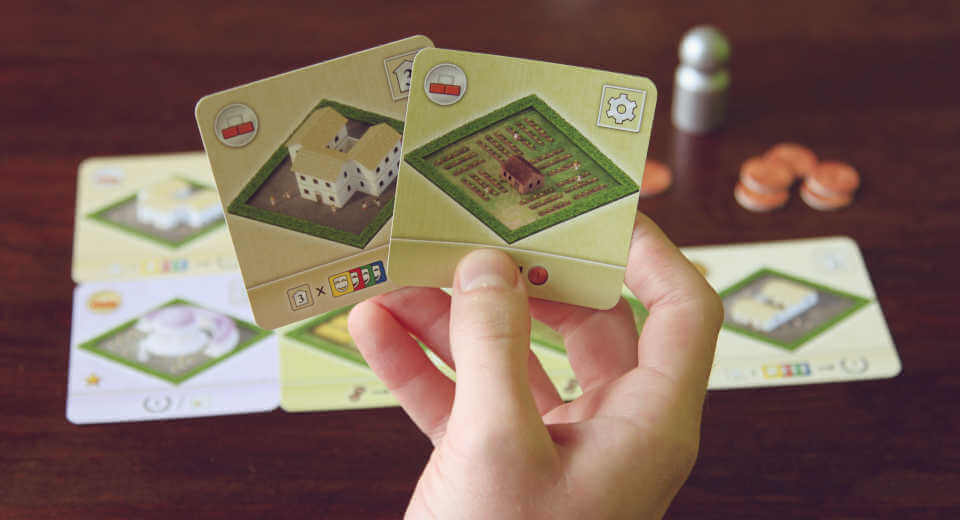
What makes the Great City of Rome board game stand out from other citybuilding board games like NEOM or Carpe Diem? The most decisive element in this game is the betting mechanism on the action strip. In each round, you have to decide whether you want to choose a card earlier or have more action points at your disposal.
The fact that the order of the building points and production points as well as the display of the building cards changes from round to round provides additional variety.
Of course, many other strategic aspects play a role in the Great City of Rome board game, such as the choice of which card to build and where to place it, these are similar to other games.
[review id=”75136″]
Pro and Con
For a connoisseur game, the Great City of Rome board game is easily accessible and not difficult to learn. Once you understand how a turn goes, you rarely need to look at the rules, which are written in a very understandable way. We also liked the fact that you can use different strategies.
In the game with four players, one of us won all the influence cards, which earned him a good chunk of points. Another player was the queen of the water supply with three aqueducts and a third player had accumulated a lot of money through strong production.
However, this player came in last place – the player who won owed her victory mainly to an almost perfect residential area with 4 blocks of flats of value 4 and adjacent to public buildings of all colours. As if that were not enough, this player also had 3 temples whose conditions she fulfilled and thus became uncatchable.
The basic gameplay of citybuilding is not new, but with the action strip, the game authors have integrated an interesting decision-making moment into the game mechanics.
For Whom Is the Great City of Rome Board Game Worthwhile?
Easy to understand and you quickly get into the game without having to look at the rules: this makes the connoisseur game suitable not only for strategy game fans but also for families. Due to the different strategic possibilities and the uninfluenceable size of chance, which decides which building cards are on display, the games also offer variety for adult rounds.
Conclusion
The Great City of Rome board game is a classic city-building game that is not only fun for connoisseurs because of its intuitive approach. Various strategies can lead to victory in ancient Rome and ensure varied games.
Take a look at our other board game tips, as well as general ideas for activities with friends, with children or as a couple.
You like our website and don’t want to miss any of our new ideas? Just follow us on Facebook and Instagram! ?
* Affiliate link: this means that if you order a product through it, we may receive a small sales commission without changing the price.

![Great City Of Rome Board Game City Planning In The Eternal City Review [Uber En="In*the*Great*City*of*Rome*board*game,*each*player*builds*a*city" De="Beim*Brettspiel*City*of*Rome*baut*jeder*Spieler*eine*Stadt"]](https://greatime.de/wp-content/uploads/2019/03/brettspiel-city-of-rome-1.jpg)
![Tyrion Lannister [Uber En="TV*drinking*games*for*popular*series*like*Game*of*Thrones" De="TV-Trinkspiele*zu*beliebten*Serien*wie*Game*of*Thrones"]](https://greatime.de/wp-content/uploads/2017/03/tv-trinkspiele-tyrion.jpg)
![Uber En Quot The German Classic Skat Card Game Quot De Quot Der Kartenspiel Klassiker Skat Quot [Uber En="In*the*Skat*card*game,*you*have*to*know*some*rules*and*understand*the*bidding." De="Beim*Kartenspiel*Skat*muss*man*einige*Regeln*kennen*und*das*Reizen*verstanden*haben"]](https://greatime.de/wp-content/uploads/2016/09/skat-regeln.jpg)
![Uber En Quot The Cursed Dollhouse By Thinkfun Quot De Quot Das Verfluchte Puppenhaus Von Thinkfun Quot [Uber En="The*Cursed*Dollhouse*by*ThinkFun" De="Das*verfluchte*Puppenhaus*von*ThinkFun"]](https://greatime.de/wp-content/uploads/2021/10/escape-the-room-verfluchte-puppenhaus-cover.jpeg)